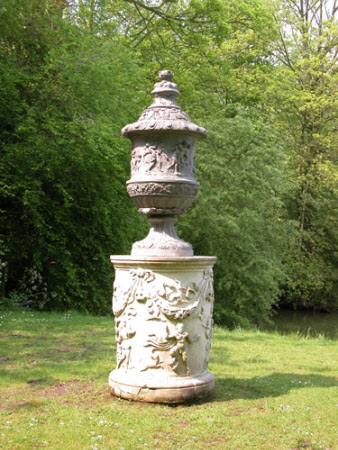Vase with the Triumph of Bacchus (The Drakelow Vase)
workshop of John Nost I (Mechelen c.1660 – London 1710-1713)
Category
Art / Sculpture
Date
1700 - 1729
Materials
Lead
Measurements
1060 mm (Height); 720 mm (Diameter)
Place of origin
London
Order this imageCollection
Anglesey Abbey, Cambridgeshire
NT 515134
Summary
Lead, urn with Triumph of Bacchus (The Drakelow Vase), probably John Nost I (d. 1710) or John Nost II (c. 1729), after Caius Gabriel Cibber (1630-1700), c. 1700-29. A lidded urn, formerly at Drakelow Hall, Burton-on-Trent, cast in lead after a marble vase carved by Caius Gabriel Cibber in c. 1690 for Hampton Court Palace. The lid with acanthus, egg and dart and scrolling foliage moulding, the body with a bas-relief showing a triumphant Bacchus driven in a chariot by Cupid and leopards followed by a procession of drunken satyrs and maenads dancing and playing musical instruments and putti frolicking with a ram. The bowl moulded with a band of scrolling acanthus and fluted, mounted on a fluted stem with scrolling acanthus. The vase mounted on a Roman marble altar (NT 516624).
Full description
The basic design is adapted from one of a pair of monumental urns carved in marble by Caius Gabriel Cibber for the Privy Garden of Hampton Court Palace in 1690 (Faber 1926, 58-9; see John Vardy after Caius Gabriel Cibber, etching, published 1749, Royal Collection Trust, RCIN 702891.b). The pendant urn was carved by the sculptor Edward Pearce (c. 1635-95) and depicted Amphitrite and Nereids. Cibber and Pearce went on to produce a further pair of urns, Cibber’s representing ‘Meleager hunting the Calydonian Boar’ (Faber 1926, 58-60, reproduced). Lead casts after Cibber’s original marble urn were most likely supplied by John Nost I (d. 1710), whose workshop was continued by his cousin, John Nost II (d. 1729). From 1700 to 1701, the elder Nost was engaged by the Office of Works in a substantial contract for Hampton Court Palace. Papers in the National Archive record payments for several commissions, including the carving of a chimneypiece in the Cartoon Gallery (TNA Works 5/50 f. 327, 5/52), the modelling of designs for garden fountains, the supply of two lead sundial figures (5/52 f. 339) and 24 garden urns, the restoration of marble statuary (5/51 f. 506), and, notably, the fluting of the marble stems belonging to Edward Pearce’s two ‘great vauses’ (5/51) and the carving of ‘eight panels and the pedestals of the said two vauses with emblems relating thereunto’ (5/52). It is probable, then, that Nost took moulds of the monumental urns around this time, given the extent of his contributions to garden statuary at Hampton Court and his completion of two of Pearce’s urns. Several lead vases, of ‘noble’ and ‘large’ dimensions, also appeared in Nost’s posthumous sale of 1712 (catalogue reproduced in O'Connell 1987, Appendix, lots 1-4, 26, 43, 53-54, 56-57, 58, 68, 72, 83). With variations in the moulding of bowls and covers, similar lead casts after the Cibber and Pearce model were supplied by Nost the Elder to Chatsworth (1690s-1701) and by John Nost II to Drayton House (1718) and Wrest Park (1725-7; reproduced Davis 1991, p. 46, pl. 1:8). Pearce’s relief of Amphitrite and the Nereids also appears on an unattributed vase at Park Place. John Davis has noted that the ‘sequence of scenes in Cibber’s original is not the same on the Anglesey Abbey example, indicating that in this case the plaster piece mould must have been assembled incorrectly’ (Davis 1991, p. 45). Variation in basic design types is generally explained by the need to renew worn-out moulds and the impetus to offer different styles. As clay models could be adapted and their piece-moulds reconfigured, it was possible to vary decorative features according to a patron’s taste or for the sake of variety of stock. The Anglesey Abbey urn originally stood in the gardens of Drakelow Hall, the Derbyshire seat of the Gresley baronets which was was demolished in 1934. The contents were auctioned in July 1931, the vase lot 2174, described as 'An antique lead urn, decorated with a frieze of classic figures, bacchanals, goats and a chariot, also bands of foliage (5ft. 3in.), also the stone pedestal and plinth'. Lord Fairhaven later mounted the urn onto an antique Roman altar (NT 516624) bought in 1948 from the collection of Sir Francis Cooke of Doughty House, Richmond. Alice Rylance-Watson 2020
Provenance
Gresley collection, Drakelow Hall, Derbyshire; sold by Sir Robert Gresley, 11th Baronet (1866–1936), 22 July, 1931, lot 2174, 'An antique lead urn, decorated with a frieze of classic figures, bacchanals, goats and a chariot, also bands of foliage (5ft. 3in.), also the stone pedestal and plinth'; purchased by Urban Huttleston Rogers Broughton, 1st Lord Fairhaven (1896-1966), from Thomas Crowther for £100 (receipt dated 30 May 1934); bequeathed to the National Trust by Lord Fairhaven with the house and the rest of the contents.
Credit line
Anglesey Abbey, The Fairhaven Collection (The National Trust)
Makers and roles
workshop of John Nost I (Mechelen c.1660 – London 1710-1713), sculptor
References
Faber 1926: Harald Faber, Caius Gabriel Cibber: 1630-1700, his life and work, Oxford 1926 O'Connell 1987: Sheila O'Connell, The Nosts: A Revision of the Family History, The Burlington Magazine, Vol. 129, No. 1017, Special Issue on European Sculpture (Dec., 1987), pp. 802-806., Appendix, p. 805. Gunnis 1968: Rupert Gunnis, Dictionary of British Sculptors 1660-1851, London 1968, 'John Nost II' Davis 1991: John Davis, Antique Garden Ornament, 300 years of creativity: Artists, manufacturers & materials, Woodbridge 1991, p. 45, pp. 46-7, pls. 1:8-9. The Gresley collection of furniture, tapestries, pictures, porcelain and works of art together with the entire contents of the mansion and outdoor effects, Hampton & Sons, John German & Sons, 14-22 July, 1931., p. 153. Roper 1964: Lanning Roper, The Gardens of Anglesey Abbey, Cambridgeshire. The Home of Lord Fairhaven, London 1964, p. 77, pl. 59. Christie, Manson & Woods 1971: The National Trust, Anglesey Abbey, Cambridge. Inventory: Furniture, Textiles, Porcelain, Bronzes, Sculpture and Garden Ornaments’, 1971, p. 162.

